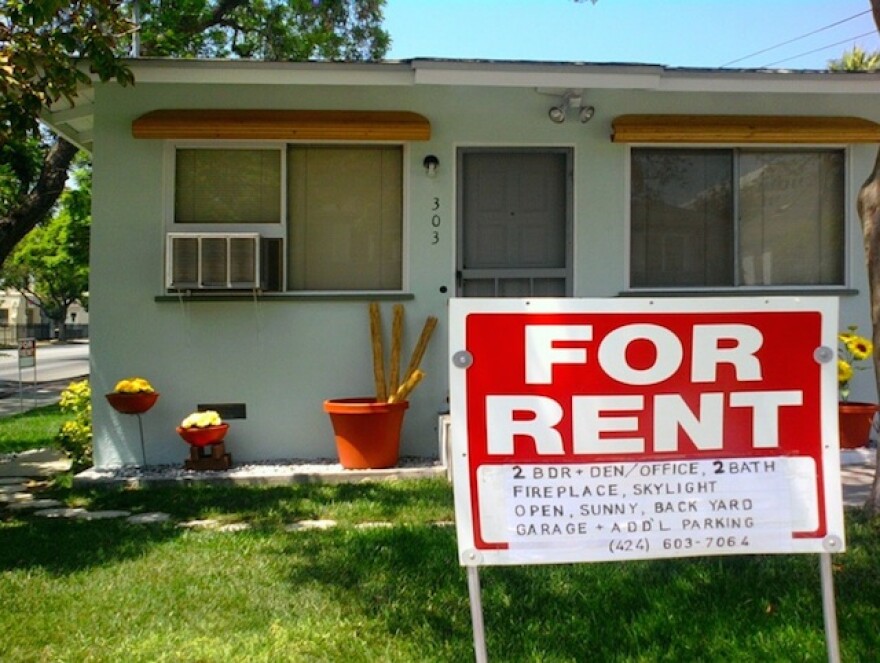This story is free to read because readers choose to support LAist. If you find value in independent local reporting, make a donation to power our newsroom today.
This is an archival story that predates current editorial management.
This archival content was written, edited, and published prior to LAist's acquisition by its current owner, Southern California Public Radio ("SCPR"). Content, such as language choice and subject matter, in archival articles therefore may not align with SCPR's current editorial standards. To learn more about those standards and why we make this distinction, please click here.
Here's Why It Costs So Much To Live In California

California's housing crisis is bad, getting worse, and isn't receiving the appropriate attention it demands from state lawmakers, reports the L.A. Times.
The reasons are simultaneously very, very simple, and quite complicated: lots of people want to live in California, but California doesn't have enough homes for those people to live in. At the same time, state, county, and municipal legislators have not made if sufficiently easy for new housing to be built quickly.
As Christopher Thornberg, an economist who studies housing, said to the Times, "You don't need a PhD in economics to understand this. It's basic supply and demand."
There isn't enough housing:
A 2015 report by California's Legislative Analyst's Office found that the State's astoundingly inflated real estate market could have likely been prevented had millions of homes and apartments had been built over the course of the past three decades, instead of the mere thousands that have been.
Though there are already roughly 3.5 million housing units in Los Angeles County, according to the U.S. Census, the LAO's report determined the county would have needed to add an extra 1 million housing units in order to keep real estate prices roughly on par with the rest of the country.
But where would these homes have gone?
Long gone are the days when Los Angeles could look out upon an undeveloped expanse and declare proudly, "And here will be a suburb called 'Covina.'" The city grew and grew until it filled up the basins and valleys we recognize today as the Greater Los Angeles Area. L.A. ran out of space to grow into, but people kept moving in, sending vacancy rates down through the basement and rents (and land values) up through the roof.
In the last quarter of 2015, Los Angeles' vacancy rate was just 2.7 percent, according to the L.A. Business Journal. As a comparison, New York's vacancy rate was 2.87 percent during the same time, according to Bloomberg. For the average renter, low vacancy rates translate into higher rents.
Today, L.A. is being forced to grapple with a fundamentally different style of planning and land development than the city has historically embraced. The era of the single-family home has ended, and the era of the 24-unit mixed-use apartment building has arrived. A lot of the current development zoo unfolding throughout our city is the result of this readjustment.
Aside from the simple question of where to build, much of Los Angeles' zoning code is quite simply obsolete, and applies to a time when single family homes—not multi-story apartment buildings—were the norm. This means even if someone is interested in building, they might not be able land zoned properly for construction. Mayor Eric Garcetti's office announced yesterday that L.A. will hire 28 new city planners to overhaul much of the city's planning code, but this will take time.
In the meantime, and indeed for the past decade or so, the city has adopted a patchwork strategy of rezoning land on a project by project basis. But these projects become susceptible to litigation claiming they failed to conduct proper environmental review. Why? Because...
It's very hard to build new housing California:
Look, I'm one of the most pro-regulatory folks I know. But even I can stand back and see that California's environmental regulation makes it very difficult to build new homes in the state.
As the Times points out, state legislators have virtually ignored trying to relax some of the highly restrictive building requirements imposed by the California Environmental Quality Act. These restrictions can often make development significantly more expensive than it needs to be, and drag out a project's timeline with years of environmental review. CEQA's regulation also makes development susceptible to litigators who (often successfully) argue that builders failed to dot their i's and cross their t's.
Instead of removing barriers to housing development, state legislators have been treating symptomatic problems, notably, by trying to increase the amount of low-income housing developed by offering subsidies offered to developers who will build apartments with below market-rate units.
These subsidies are crucially needed, especially given that the average Angeleno pays more than 30 percent of their income on housing, and 1.7 million households statewide pay more than half (the national average is just 23 percent).
California has found itself in a conundrum. It's too costly and prohibitive to build lots of new housing—and by not building more housing it's only going to become more expensive.







